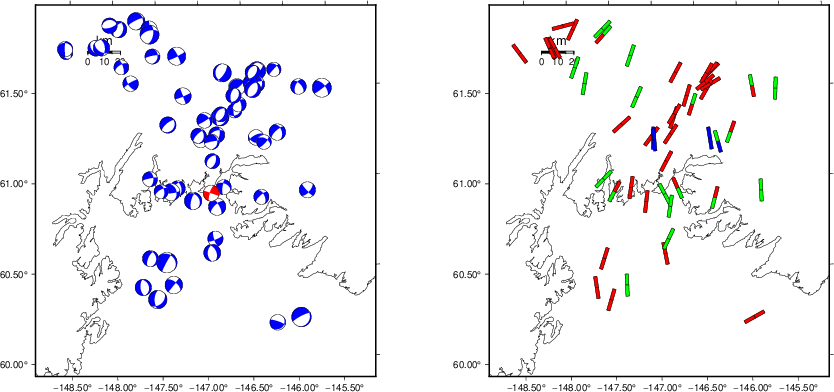Location
Location ANSS
The ANSS event ID is ak02597300y3 and the event page is at
https://earthquake.usgs.gov/earthquakes/eventpage/ak02597300y3/executive.
2025/07/19 19:34:44 60.933 -146.907 19.2 4.1 Alaska
Focal Mechanism
USGS/SLU Moment Tensor Solution
ENS 2025/07/19 19:34:44.0 60.93 -146.91 19.2 4.1 Alaska
Stations used:
AK.BAE AK.BMR AK.BPAW AK.DHY AK.DIV AK.FID AK.FIRE AK.GHO
AK.GLB AK.HDA AK.HIN AK.K24K AK.KAI AK.KLU AK.KNK AK.L22K
AK.L26K AK.M20K AK.M26K AK.MESA AK.P23K AK.PAX AK.PPLA
AK.PWL AK.RAG AK.RC01 AK.RND AK.SAW AK.SCM AK.SLK AK.SWD
AK.TGL AK.VRDI AK.WAT6 AK.WRH AT.PMR AV.WAZA
Filtering commands used:
cut o DIST/3.3 -40 o DIST/3.3 +50
rtr
taper w 0.1
hp c 0.03 n 3
lp c 0.08 n 3
Best Fitting Double Couple
Mo = 1.26e+22 dyne-cm
Mw = 4.00
Z = 27 km
Plane Strike Dip Rake
NP1 290 90 -165
NP2 200 75 0
Principal Axes:
Axis Value Plunge Azimuth
T 1.26e+22 11 64
N 0.00e+00 75 290
P -1.26e+22 11 156
Moment Tensor: (dyne-cm)
Component Value
Mxx -7.82e+21
Mxy 9.32e+21
Mxz 3.06e+21
Myy 7.82e+21
Myz 1.11e+21
Mzz 0.00e+00
--------------
----------------######
------------------##########
-----------------#############
------------------################
------------------###############
------------------################ T #
##----------------################# ##
#######-----------######################
#############-----########################
#################-########################
#################-------##################
################-------------#############
###############------------------#######
##############------------------------##
#############-------------------------
###########-------------------------
##########------------------------
########----------------------
#######------------- -----
####------------- P --
-------------
Global CMT Convention Moment Tensor:
R T P
0.00e+00 3.06e+21 -1.11e+21
3.06e+21 -7.82e+21 -9.32e+21
-1.11e+21 -9.32e+21 7.82e+21
Details of the solution is found at
http://www.eas.slu.edu/eqc/eqc_mt/MECH.NA/20250719193444/index.html
|
Preferred Solution
The preferred solution from an analysis of the surface-wave spectral amplitude radiation pattern, waveform inversion or first motion observations is
STK = 200
DIP = 75
RAKE = 0
MW = 4.00
HS = 27.0
The NDK file is 20250719193444.ndk
The waveform inversion is preferred.
Moment Tensor Comparison
The following compares this source inversion to those provided by others. The purpose is to look for major differences and also to note slight differences that might be inherent to the processing procedure. For completeness the USGS/SLU solution is repeated from above.
| SLU |
USGSMWR |
USGS/SLU Moment Tensor Solution
ENS 2025/07/19 19:34:44.0 60.93 -146.91 19.2 4.1 Alaska
Stations used:
AK.BAE AK.BMR AK.BPAW AK.DHY AK.DIV AK.FID AK.FIRE AK.GHO
AK.GLB AK.HDA AK.HIN AK.K24K AK.KAI AK.KLU AK.KNK AK.L22K
AK.L26K AK.M20K AK.M26K AK.MESA AK.P23K AK.PAX AK.PPLA
AK.PWL AK.RAG AK.RC01 AK.RND AK.SAW AK.SCM AK.SLK AK.SWD
AK.TGL AK.VRDI AK.WAT6 AK.WRH AT.PMR AV.WAZA
Filtering commands used:
cut o DIST/3.3 -40 o DIST/3.3 +50
rtr
taper w 0.1
hp c 0.03 n 3
lp c 0.08 n 3
Best Fitting Double Couple
Mo = 1.26e+22 dyne-cm
Mw = 4.00
Z = 27 km
Plane Strike Dip Rake
NP1 290 90 -165
NP2 200 75 0
Principal Axes:
Axis Value Plunge Azimuth
T 1.26e+22 11 64
N 0.00e+00 75 290
P -1.26e+22 11 156
Moment Tensor: (dyne-cm)
Component Value
Mxx -7.82e+21
Mxy 9.32e+21
Mxz 3.06e+21
Myy 7.82e+21
Myz 1.11e+21
Mzz 0.00e+00
--------------
----------------######
------------------##########
-----------------#############
------------------################
------------------###############
------------------################ T #
##----------------################# ##
#######-----------######################
#############-----########################
#################-########################
#################-------##################
################-------------#############
###############------------------#######
##############------------------------##
#############-------------------------
###########-------------------------
##########------------------------
########----------------------
#######------------- -----
####------------- P --
-------------
Global CMT Convention Moment Tensor:
R T P
0.00e+00 3.06e+21 -1.11e+21
3.06e+21 -7.82e+21 -9.32e+21
-1.11e+21 -9.32e+21 7.82e+21
Details of the solution is found at
http://www.eas.slu.edu/eqc/eqc_mt/MECH.NA/20250719193444/index.html
|
Regional Moment Tensor (Mwr)
Moment 1.462e+15 N-m
Magnitude 4.04 Mwr
Depth 26.0 km
Percent DC 96%
Half Duration -
Catalog US
Data Source US
Contributor US
Nodal Planes
Plane Strike Dip Rake
NP1 197 74 -1
NP2 287 89 -164
Principal Axes
Axis Value Plunge Azimuth
T 1.477e+15 11 61
N -0.031e+15 74 290
P -1.446e+15 12 153
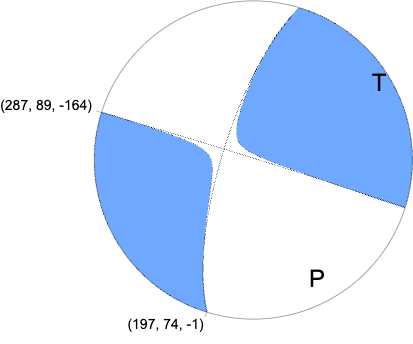
|
Magnitudes
Given the availability of digital waveforms for determination of the moment tensor, this section documents the added processing leading to mLg, if appropriate to the region, and ML by application of the respective IASPEI formulae. As a research study, the linear distance term of the IASPEI formula
for ML is adjusted to remove a linear distance trend in residuals to give a regionally defined ML. The defined ML uses horizontal component recordings, but the same procedure is applied to the vertical components since there may be some interest in vertical component ground motions. Residual plots versus distance may indicate interesting features of ground motion scaling in some distance ranges. A residual plot of the regionalized magnitude is given as a function of distance and azimuth, since data sets may transcend different wave propagation provinces.
ML Magnitude

Left: ML computed using the IASPEI formula for Horizontal components. Center: ML residuals computed using a modified IASPEI formula that accounts for path specific attenuation; the values used for the trimmed mean are indicated. The ML relation used for each figure is given at the bottom of each plot.
Right: Residuals from new relation as a function of distance and azimuth.

Left: ML computed using the IASPEI formula for Vertical components (research). Center: ML residuals computed using a modified IASPEI formula that accounts for path specific attenuation; the values used for the trimmed mean are indicated. The ML relation used for each figure is given at the bottom of each plot.
Right: Residuals from new relation as a function of distance and azimuth.
Context
The left panel of the next figure presents the focal mechanism for this earthquake (red) in the context of other nearby events (blue) in the SLU Moment Tensor Catalog. The right panel shows the inferred direction of maximum compressive stress and the type of faulting (green is strike-slip, red is normal, blue is thrust; oblique is shown by a combination of colors). Thus context plot is useful for assessing the appropriateness of the moment tensor of this event.
Waveform Inversion using wvfgrd96
The focal mechanism was determined using broadband seismic waveforms. The location of the event (star) and the
stations used for (red) the waveform inversion are shown in the next figure.
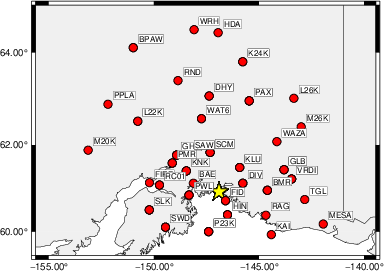
|
|
Location of broadband stations used for waveform inversion
|
The program wvfgrd96 was used with good traces observed at short distance to determine the focal mechanism, depth and seismic moment. This technique requires a high quality signal and well determined velocity model for the Green's functions. To the extent that these are the quality data, this type of mechanism should be preferred over the radiation pattern technique which requires the separate step of defining the pressure and tension quadrants and the correct strike.
The observed and predicted traces are filtered using the following gsac commands:
cut o DIST/3.3 -40 o DIST/3.3 +50
rtr
taper w 0.1
hp c 0.03 n 3
lp c 0.08 n 3
The results of this grid search are as follow:
DEPTH STK DIP RAKE MW FIT
WVFGRD96 1.0 285 80 -5 3.33 0.1977
WVFGRD96 2.0 20 80 10 3.47 0.2755
WVFGRD96 3.0 20 80 5 3.53 0.3156
WVFGRD96 4.0 20 85 5 3.57 0.3442
WVFGRD96 5.0 20 80 10 3.61 0.3649
WVFGRD96 6.0 20 75 10 3.65 0.3864
WVFGRD96 7.0 20 80 10 3.68 0.4093
WVFGRD96 8.0 20 75 15 3.72 0.4357
WVFGRD96 9.0 195 75 -15 3.75 0.4551
WVFGRD96 10.0 195 75 -10 3.78 0.4728
WVFGRD96 11.0 195 75 -10 3.80 0.4904
WVFGRD96 12.0 195 75 -10 3.82 0.5079
WVFGRD96 13.0 195 75 -10 3.83 0.5247
WVFGRD96 14.0 195 75 -10 3.85 0.5398
WVFGRD96 15.0 200 75 -5 3.87 0.5544
WVFGRD96 16.0 200 75 -5 3.88 0.5676
WVFGRD96 17.0 200 75 -5 3.90 0.5792
WVFGRD96 18.0 200 75 -5 3.91 0.5896
WVFGRD96 19.0 200 75 -5 3.92 0.5989
WVFGRD96 20.0 200 75 -5 3.94 0.6072
WVFGRD96 21.0 195 75 -5 3.95 0.6145
WVFGRD96 22.0 195 75 -5 3.96 0.6204
WVFGRD96 23.0 195 75 -5 3.97 0.6257
WVFGRD96 24.0 200 75 0 3.98 0.6299
WVFGRD96 25.0 200 75 0 3.99 0.6328
WVFGRD96 26.0 200 75 0 3.99 0.6348
WVFGRD96 27.0 200 75 0 4.00 0.6355
WVFGRD96 28.0 195 75 -5 4.01 0.6348
WVFGRD96 29.0 195 75 -5 4.01 0.6329
WVFGRD96 30.0 200 75 0 4.02 0.6292
WVFGRD96 31.0 195 80 -5 4.02 0.6252
WVFGRD96 32.0 195 80 0 4.03 0.6201
WVFGRD96 33.0 195 80 0 4.04 0.6143
WVFGRD96 34.0 195 80 0 4.04 0.6068
WVFGRD96 35.0 195 80 0 4.05 0.5986
WVFGRD96 36.0 195 80 0 4.06 0.5909
WVFGRD96 37.0 195 85 0 4.07 0.5839
WVFGRD96 38.0 195 85 0 4.08 0.5799
WVFGRD96 39.0 195 85 0 4.10 0.5786
WVFGRD96 40.0 195 80 0 4.12 0.5774
WVFGRD96 41.0 195 85 0 4.13 0.5799
WVFGRD96 42.0 195 85 0 4.14 0.5805
WVFGRD96 43.0 195 85 0 4.15 0.5796
WVFGRD96 44.0 195 85 0 4.16 0.5779
WVFGRD96 45.0 195 85 0 4.17 0.5753
WVFGRD96 46.0 195 85 0 4.18 0.5723
WVFGRD96 47.0 15 85 -5 4.18 0.5693
WVFGRD96 48.0 15 85 -5 4.19 0.5672
WVFGRD96 49.0 15 85 -5 4.20 0.5642
WVFGRD96 50.0 15 85 -5 4.20 0.5614
WVFGRD96 51.0 15 85 -5 4.21 0.5592
WVFGRD96 52.0 200 90 5 4.21 0.5552
WVFGRD96 53.0 15 85 -5 4.22 0.5531
WVFGRD96 54.0 15 85 -5 4.22 0.5519
WVFGRD96 55.0 200 90 10 4.23 0.5487
WVFGRD96 56.0 200 90 10 4.23 0.5464
WVFGRD96 57.0 15 85 -5 4.23 0.5451
WVFGRD96 58.0 15 85 -5 4.24 0.5424
WVFGRD96 59.0 15 85 -5 4.24 0.5407
The best solution is
WVFGRD96 27.0 200 75 0 4.00 0.6355
The mechanism corresponding to the best fit is
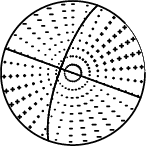
|
|
Figure 1. Waveform inversion focal mechanism
|
The best fit as a function of depth is given in the following figure:
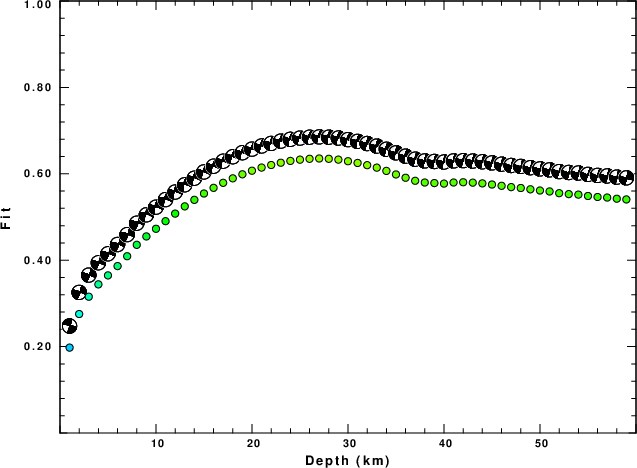
|
|
Figure 2. Depth sensitivity for waveform mechanism
|
The comparison of the observed and predicted waveforms is given in the next figure. The red traces are the observed and the blue are the predicted.
Each observed-predicted component is plotted to the same scale and peak amplitudes are indicated by the numbers to the left of each trace. A pair of numbers is given in black at the right of each predicted traces. The upper number it the time shift required for maximum correlation between the observed and predicted traces. This time shift is required because the synthetics are not computed at exactly the same distance as the observed, the velocity model used in the predictions may not be perfect and the epicentral parameters may be be off.
A positive time shift indicates that the prediction is too fast and should be delayed to match the observed trace (shift to the right in this figure). A negative value indicates that the prediction is too slow. The lower number gives the percentage of variance reduction to characterize the individual goodness of fit (100% indicates a perfect fit).
The bandpass filter used in the processing and for the display was
cut o DIST/3.3 -40 o DIST/3.3 +50
rtr
taper w 0.1
hp c 0.03 n 3
lp c 0.08 n 3

|
|
Figure 3. Waveform comparison for selected depth. Red: observed; Blue - predicted. The time shift with respect to the model prediction is indicated. The percent of fit is also indicated. The time scale is relative to the first trace sample.
|
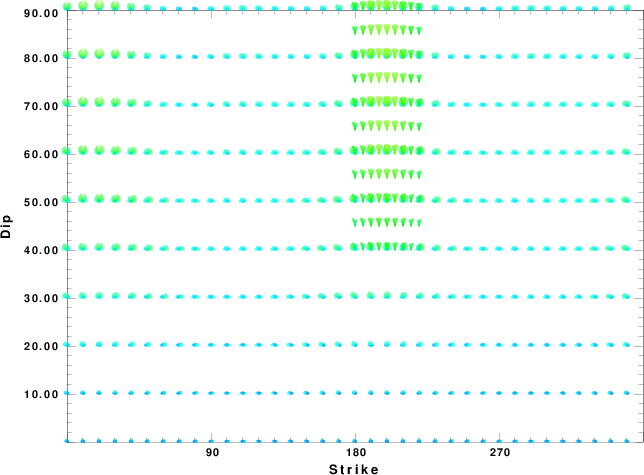
|
|
Focal mechanism sensitivity at the preferred depth. The red color indicates a very good fit to the waveforms.
Each solution is plotted as a vector at a given value of strike and dip with the angle of the vector representing the rake angle, measured, with respect to the upward vertical (N) in the figure.
|
A check on the assumed source location is possible by looking at the time shifts between the observed and predicted traces. The time shifts for waveform matching arise for several reasons:
- The origin time and epicentral distance are incorrect
- The velocity model used for the inversion is incorrect
- The velocity model used to define the P-arrival time is not the
same as the velocity model used for the waveform inversion
(assuming that the initial trace alignment is based on the
P arrival time)
Assuming only a mislocation, the time shifts are fit to a functional form:
Time_shift = A + B cos Azimuth + C Sin Azimuth
The time shifts for this inversion lead to the next figure:
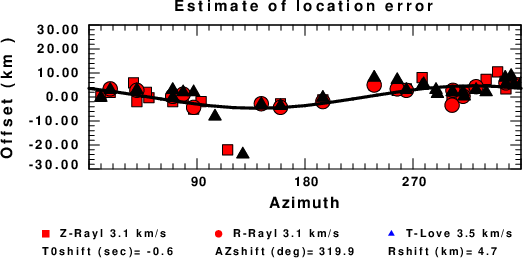
The derived shift in origin time and epicentral coordinates are given at the bottom of the figure.
Velocity Model
The WUS.model used for the waveform synthetic seismograms and for the surface wave eigenfunctions and dispersion is as follows
(The format is in the model96 format of Computer Programs in Seismology).
MODEL.01
Model after 8 iterations
ISOTROPIC
KGS
FLAT EARTH
1-D
CONSTANT VELOCITY
LINE08
LINE09
LINE10
LINE11
H(KM) VP(KM/S) VS(KM/S) RHO(GM/CC) QP QS ETAP ETAS FREFP FREFS
1.9000 3.4065 2.0089 2.2150 0.302E-02 0.679E-02 0.00 0.00 1.00 1.00
6.1000 5.5445 3.2953 2.6089 0.349E-02 0.784E-02 0.00 0.00 1.00 1.00
13.0000 6.2708 3.7396 2.7812 0.212E-02 0.476E-02 0.00 0.00 1.00 1.00
19.0000 6.4075 3.7680 2.8223 0.111E-02 0.249E-02 0.00 0.00 1.00 1.00
0.0000 7.9000 4.6200 3.2760 0.164E-10 0.370E-10 0.00 0.00 1.00 1.00
Last Changed Sat Jul 19 16:31:27 CDT 2025



